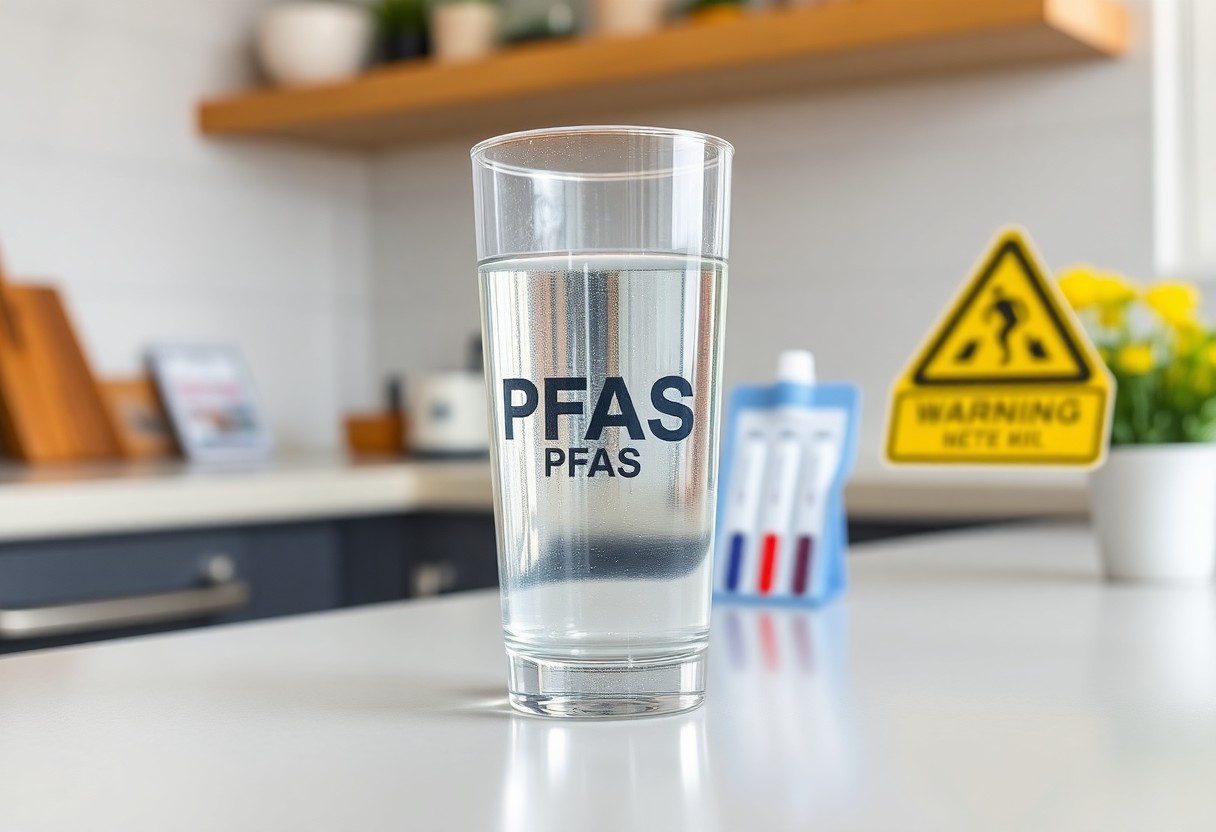PFAS, or per- and polyfluoroalkyl substances, are synthetic chemicals that can pose serious risks to your health and the environment. These substances are often found in drinking water, primarily due to industrial contamination and the use of certain consumer products. It is imperative for you to understand the potential long-term effects of PFAS exposure, including links to various health issues like cancer and liver damage. In this blog post, you will discover everything you need to know about PFAS chemicals, their sources, and how to protect yourself and your family.
Understanding PFAS Chemicals
While you may have heard about PFAS chemicals in relation to drinking water, understanding their significance is vital. PFAS, or per- and polyfluoroalkyl substances, are a group of synthetic chemicals used in various industrial and consumer products for their water- and grease-resistant properties. These chemicals are persistent in the environment, raising concerns about their presence in your drinking water and their potential health effects.
Definition and Characteristics
One key aspect of PFAS chemicals is their unique molecular structure, which includes a chain of carbon atoms surrounded by fluorine atoms. This configuration makes them incredibly stable and resistant to degradation, which is why they are often referred to as “forever chemicals.” Their durability means that they can accumulate in the environment and in your body over time, leading to potential health risks.
Sources of PFAS Contamination
Along with their widespread use, various sources contribute to PFAS contamination in drinking water, including industrial discharges, landfills, and military firefighting training sites. These chemicals can leach into groundwater or surface water, affecting your drinking water supply.
But it’s necessary to be aware that common sources of PFAS contamination include manufacturing facilities that produce these chemicals, firefighting foam used in emergency situations, and water runoff from landfills containing products treated with PFAS. These sources can significantly impact your drinking water quality, making it vital to monitor and seek solutions for reducing exposure to these harmful substances.
Health Risks Associated with PFAS
Clearly, PFAS chemicals pose significant health risks, including potential links to various diseases and health conditions. Exposure to these substances through contaminated drinking water can lead to serious issues, such as increased cholesterol levels, liver damage, immune system effects, and even certain cancers. Understanding these risks is vital for you and your loved ones as you navigate water safety and health precautions.
Effects on Human Health
Before stepping into the specifics, it’s necessary to recognize that PFAS exposure can lead to a multitude of health problems. Studies suggest that these chemicals are associated with adverse outcomes like thyroid disease, pregnancy complications, and developmental delays in children. This highlights the importance of monitoring your exposure to ensure a healthier future.
Vulnerable Populations
After discussing the general effects, it’s important to identify vulnerable populations that may be at higher risk from PFAS exposure. Groups such as children, pregnant women, and those with pre-existing health conditions are particularly susceptible to the harmful effects of PFAS chemicals. Recognizing these at-risk groups can enhance your understanding of how to protect the most vulnerable individuals in your community.
Populations that are particularly affected by PFAS exposure include young children, whose developing bodies may react more severely to toxic substances. Pregnant women are also at heightened risk, as PFAS can cross the placenta and potentially affect fetal development. Additionally, those with weakened immune systems or chronic health issues may face more significant challenges when exposed to these chemicals. It is vital for you to be aware of your surroundings and advocate for safe drinking water, especially if you belong to any of these vulnerable groups.
Regulations and Standards
You should be aware that regulations and standards for PFAS in drinking water vary significantly and can impact your health and safety. The Environmental Protection Agency (EPA) provides guidelines, but these may not be uniform across all states. Understanding these regulations is vital to ensuring the safety of your drinking water and protecting your well-being.
Current Guidelines for PFAS in Drinking Water
PFAS chemicals are currently monitored by the EPA, which recently established a *health advisory level* of 70 parts per trillion for certain PFAS compounds. These guidelines are designed to limit exposure and protect public health, but they are not legally binding. Your local water systems may have to adapt to these suggestions while further researching the long-term effects of these substances.
State vs. Federal Regulations
About regulations governing PFAS, state guidelines often differ from federal standards, leading to potential inconsistencies in water safety. While the EPA sets a baseline with its health advisory levels, many states have enacted their own stricter regulations to combat contamination. This variation can affect your community’s drinking water safety, as some states enforce lower limits than those established by the federal government.
In addition, some states are more proactive than others in addressing PFAS contamination, implementing legislations that require regular testing and public disclosure regarding PFAS levels in drinking water supplies. While federal guidelines provide a framework, your state’s stricter rules may offer greater protection, allowing you to stay informed about potential risks in your local water supply. It’s vital for you to stay updated on these regulations, as they can significantly affect your health and the quality of your drinking water.

Testing for PFAS in Water
Now that you understand the significance of PFAS in drinking water, it’s crucial to know how to test for its presence. Testing can provide clarity on whether your water supply is safe or poses health risks. You’ll find various methods to assess water quality, giving you the information needed to protect yourself and your family.
Methods of Detection
Along with standard water testing kits, laboratories offer advanced techniques to detect PFAS levels. These methods include Liquid Chromatography-Tandem Mass Spectrometry (LC-MS/MS), which allows for precise measurement of multiple PFAS compounds. Many communities now leverage these technologies to ensure the safety of municipal water sources.
Understanding Test Results
About reading test results, it’s vital to comprehend what the numbers mean for your health. You’ll typically see results expressed in parts per trillion (ppt), which quantify the concentration of PFAS. It’s crucial to check the Environmental Protection Agency (EPA) guidelines to see if your levels exceed recommended limits.
For instance, if you test your water and discover PFAS levels around 80 ppt, this exceeds the EPA’s recommended limit of 70 ppt for total PFAS concentration. Such findings indicate a potential health risk, including links to cancer and liver damage. It’s wise to make decisions about your water, possibly seeking alternative sources, investing in PFAS filters, or contacting local authorities for remediation options.
Remediation Techniques
Unlike traditional pollutants, PFAS chemicals require specialized remediation techniques due to their chemical stability and resistance to degradation. These methods aim to reduce contamination levels in drinking water, reclaiming safe sources for communities and ensuring adequate public health measures.
Filtration Methods
Against common water contaminants, PFAS often demand rigorous filtration methods like granular activated carbon (GAC) and reverse osmosis. These techniques are effective in capturing PFAS molecules and preventing them from entering your drinking water, making them crucial in purifying water supplies.
Emerging Technologies
An exciting aspect of PFAS remediation involves emerging technologies, which show promise in effectively tackling these stubborn chemicals.
Consequently, advancements such as ion exchange resins and advanced oxidation processes have surfaced, enhancing the ability to treat PFAS-contaminated water. These technologies not only aim to effectively remove PFAS but also reduce the environmental footprint of remediation efforts. By utilizing these methods, you could witness improved safety in your water supply and a step toward eliminating the long-lasting impacts of PFAS in your environment.
Preventing PFAS Contamination
To prevent PFAS contamination in your drinking water, it is imperative to advocate for stronger regulations and adopt best practices in your community. Supporting local initiatives, such as hazardous waste disposal programs, and encouraging industries to adopt safer alternatives can significantly reduce emissions of these harmful chemicals. You can play an active role by staying informed and participating in discussions about water quality and environmental protections.
Community Action
On a community level, fostering awareness about the dangers of PFAS and engaging in grassroots initiatives are vital steps toward contamination prevention. Encourage local leaders to implement policies restricting PFAS usage, hold informational meetings, and collaborate with environmental organizations to enhance community resilience against pollution.
Individual Precautions
Among individual actions you can take, being mindful of the products you use in your home is imperative in reducing PFAS exposure. Opt for PFAS-free products when possible, and avoid non-stick cookware and water-resistant fabrics that may contain these chemicals. Regularly check your local water quality reports, and consider testing your drinking water if you suspect contamination.
A proactive approach to individual precautions can significantly minimize the risk of PFAS exposure in your daily life. You should always choose safe alternatives for cleaning products, food packaging, and personal care items. Educating yourself about the sources of PFAS, such as firefighting foam and certain industrial processes, empowers you to make informed choices. By implementing these changes, you contribute to a healthier environment and help protect your health and the well-being of your community.
To wrap up
Upon reflecting on the implications of PFAS chemicals in your drinking water, it is important to stay informed about their potential health impacts and regulations. Understanding the sources of these chemicals and their influence on water quality empowers you to take proactive steps in safeguarding your health and that of your community. By being aware of the testing options available and advocating for safer drinking water standards, you contribute to a collective effort towards a healthier future for everyone. Stay vigilant and engaged in protecting your water supply from harmful contaminants.





















